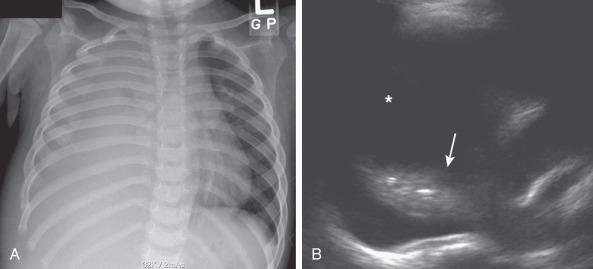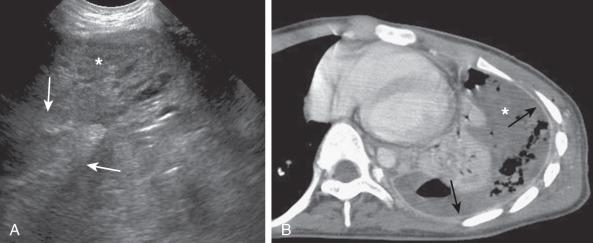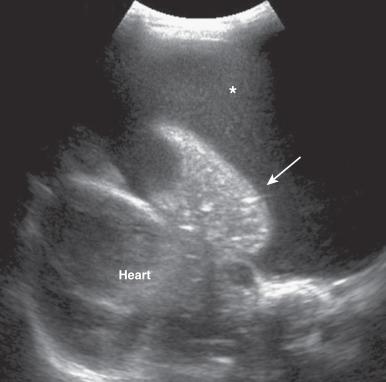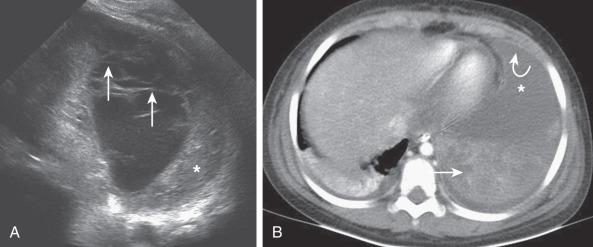Physical Address
304 North Cardinal St.
Dorchester Center, MA 02124
The pleura is a serous membrane consisting of two layers, the visceral and the parietal pleura. The parietal pleura covers the inner aspect of the chest wall and the diaphragm. The visceral pleura is strongly adherent to the surface of the lungs and interlobar fissures. In normal conditions, no imaging study can visualize the pleural space because pleural membranes are only 0.2 to 0.4 mm thick, and the physiologic volume of pleural fluid forms a thin 5- to 10-micron layer. However, in children, various pathologic processes can occur within this space that require imaging evaluation. In this chapter, etiologies, imaging characteristics, treatment, and follow-up of pathologic processes involving the pleura are discussed.
The lymphatic system plays an important role in the homeostasis of pleural fluid. Excess production or decreased absorption of lymphatic fluid can result in an increased volume of pleural fluid.
Causes of pleural effusion in pediatric patients differ substantially from those in adults. Whereas the most frequent cause of pleural effusions in adults is congestive heart failure, pleural effusions in children are most commonly a result of underlying pleuropulmonary infection ( Table 60.1 ). Although pediatric patients with small pleural effusions are usually asymptomatic, large pleural effusions can result in symptomatic respiratory distress or inspiratory pleuritic chest pain as a result of stretching or irritation of the parietal pleura. When infection is the underlying cause, the predominant symptoms are cough, dyspnea, fever, and elevated white blood cell counts.
| Phase | Description |
|---|---|
| Exudative | Pleural inflammation leads to accumulation of free-flowing clear liquid |
| Fibrinopurulent | Deposition of fibrin in the pleural space results in septation/loculations limiting the flow of fluid; pus accumulates in the pleural cavity |
| Organizing phase | Fibroblasts infiltrate the pleura, forming a rigid pleura and preventing lung expansion |
Chest radiography plays an important first-line role in the initial diagnosis of pleural effusions in children. The radiographic appearance depends on the volume and consistency of the pleural fluid, the patient's position, and the presence of septations and/or loculations. On chest radiographs, a free-flowing effusion forms an internally concave meniscus paralleling the chest wall that changes in position on lateral decubitus radiographs. On supine radiographs, mobile fluid may layer over the hemithorax, resulting in diffuse opacity. The presence of a lentiform-shaped effusion with internal convex margins is suggestive of a loculated pleural effusion.
The most common indication of chest ultrasound in children is to characterize an opaque hemithorax seen on a chest radiograph ( Fig. 60.1 ). Ultrasound is the best imaging modality for diagnosing and characterizing pleural fluid. Ultrasound is more sensitive than radiographs in detecting pleural fluid, particularly when the amount is small (approximately 5 mL).

The internal echogenicity of pleural effusions on ultrasound can be categorized into four types ( Table 60.2 ): (1) homogeneously anechoic (see Fig. 60.1B ); (2) nonseptated with internal low-level echoes ( e-Fig. 60.2 ); (3) septated ( e-Fig. 60.3A ); and (4) homogeneously echogenic ( Fig. 60.4A ). Anechoic and free-flowing effusions are called simple pleural effusions, and the remainder are classified as complex pleural effusions.
| Type of Effusion | Description |
|---|---|
| Simple | Homogeneously anechoic |
| Complex | Nonseptated with internal low-level echoes |
| Multiseptated | |
| Homogenously echogenic |



Computed tomography (CT) also is more sensitive than chest radiographs in detecting small pleural effusions. The advantage of CT is that it provides an unobstructed view of the entire underlying lung parenchyma, mediastinum, and chest wall; however, it is associated with ionizing radiation exposure. Intravenous administration of contrast material is necessary to optimally visualize and assess the pleura and lung parenchyma ( Fig. 60.4B ). In comparison to ultrasound, CT is limited in characterizing pleural effusions and demonstrating internal septations (see e-Fig. 60.3 ).
Thoracentesis is useful in evaluating the underlying cause of a pleural effusion and also in relieving symptoms. Indications for thoracentesis in children with pleural effusions are persistent fever, respiratory compromise, mediastinal shift, pleuritic pain, and underlying lung disease.
Become a Clinical Tree membership for Full access and enjoy Unlimited articles
If you are a member. Log in here